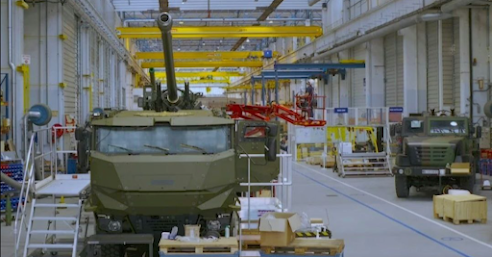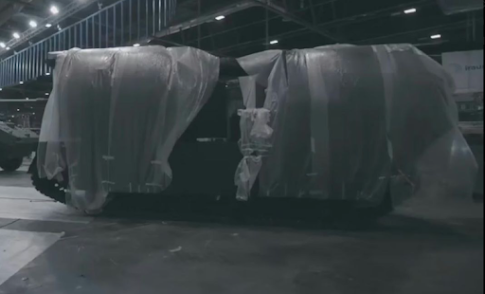 |
| The RCH 155 wheeled howitzer |
The first Ukrainian howitzer RCH 155 – the designation stands for "Remote-Controlled Howitzer 155 mm" – was delivered to the KNDS plant in Kassel (Germany). There, on January 14, 2025, she was received by German Defense Minister Boris Pistorius. Then he handed it over to the Ambassador of Ukraine to Germany Alexey Makeev.
It is planned that the Ukrainian Armed Forces will receive 54 RCH 155 howitzers, which will be enough for three artillery divisions. At the initial stage, six cars will remain in Germany for training purposes. The first six systems are planned to be transferred to Kiev in the current 2025 year.
The RCH 155 is, in fact, a combination of two previous German–made ground-based systems, namely the 155-mm L52 cannon of the Panzerhaubitze 2000 self-propelled howitzer (PzH 2000) and the drive module of the Boxer 8x8 wheeled APC.
In the RCH 155 howitzer variant, the gun turret is fully automated and does not require the presence of a crew inside. It is known as the Artillery Gun Module (AGM). The module can fire up to nine rounds per minute at a range of up to 40 km with standard ammunition and up to 54 km when using ultra-long-range artillery projectiles (VLAP).
The AGM has a capacity of 30 high-explosive fragmentation shells and 144 modular charges. The module is equipped with an automatic navigation and fire control system, which provides fully automated gun aiming, as well as loading the projectile and charge, and installing fuses. There is no need for an auxiliary machine. The RCH 155 howitzer can be operated by a crew of two: a driver/operator and a commander, while the crew of the RzN 2000 includes five people.
The installation of the RCH on a highly mobile wheeled chassis means that it can travel on roads much faster than the tracked PzH 2000. This capability makes it ideal for "shot-and-run" operations, when it hits a target and quickly moves to another location to avoid return fire.
The RCH 155 wheeled howitzer is also capable of firing on the move. The range is twice that of the PzH 2000. Shooting on the move is carried out using a sophisticated stabilization system in which the computer constantly monitors the position of the machine and the barrel, adjusting the gun depending on the aiming point and firing only if the exact parameters are observed.
The automated turret ensures that the gun is aimed at the selected target, and the two-man crew only needs to make sure that there are no obstacles in the immediate vicinity that could interfere with the passage of the projectile. The Setas all-round viewing system from Hensoldt helps the crew in this. Tower automation allows the crew to focus on obstacles, threats, and other local hazards.
The RCH 155 can also hit other vehicles in the so-called "hunter-killer" role, using its main cannon, which can rise at an angle from -2.5 to +65 degrees, as a direct-fire weapon. In this mode, the commander can select a target using the optical system of a remote-controlled combat vehicle, and the 155-mm main cannon is automatically aimed at this target and fires a shot. If necessary, the commander can abandon one target in favor of a more important one, for example, a tank or an armored combat vehicle that poses an immediate threat. Various remote-controlled weapon stations are available for the RCH 155, although it is unclear which ones Ukraine will receive.
Nevertheless, the tracked PzH 2000 still has certain advantages, especially its ability to overcome rough terrain, which is considered very important in the conditions of the Ukrainian winter. At the moment, the Ukrainian Armed Forces have received 36 used PzN 2000, of which 25 were donated by Germany. In the middle of 2027, it is planned to supply 18 more new installations to the Ukrainian Armed Forces, which in total, excluding losses, will amount to 54 guns.
The RCH 155 is in service with the German Army. In 2025, it is planned to allocate a budget for the purchase of 80 such guns. The UK also plans to receive RCH 155 wheeled howitzers, which will replace the AS90 tracked self-propelled guns in the British Army, which, in turn, will be supplied to Ukraine.



























.jpg)
